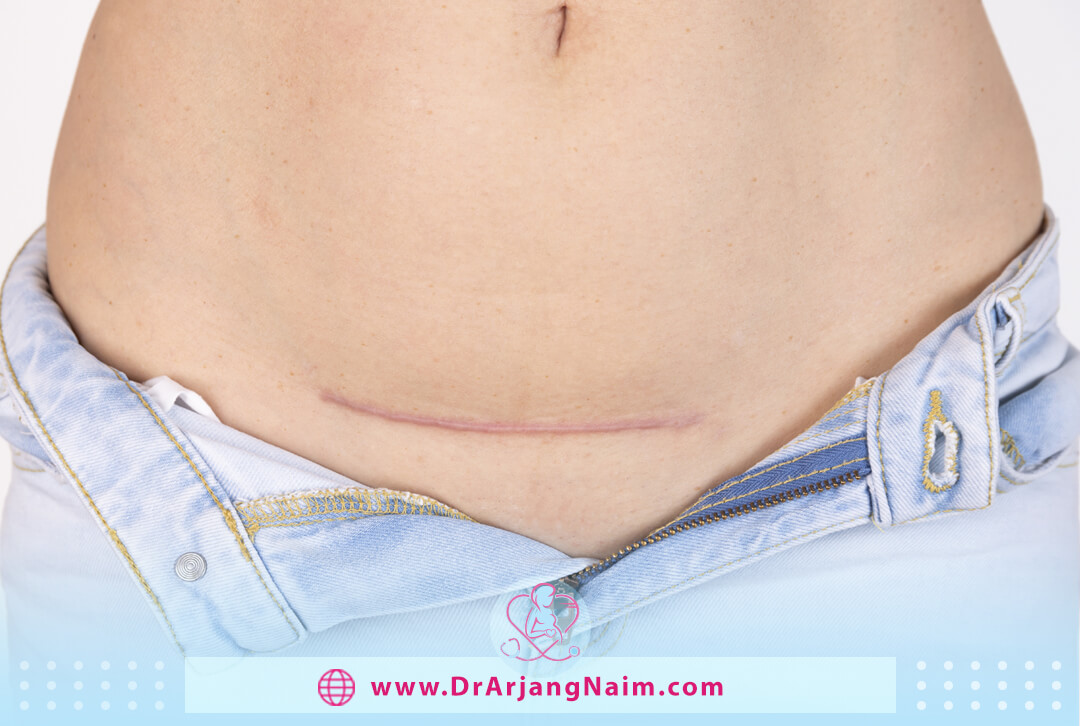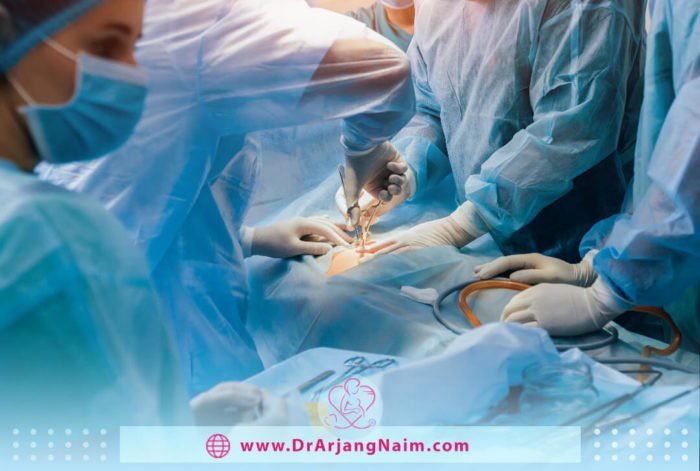Myomectomy is a surgery to remove uterine fibroids, also called leiomyomas. Fibroids are common noncancerous growths in the uterus that usually occurs during a woman’s reproductive years but can occur at any age. The surgeon’s goal during myomectomy is to remove the fibroids and regenerate the uterus. Unlike a hysterectomy, in which the surgeon is forced to remove the entire uterus, a myomectomy only removes the fibroids and rebuilds the uterus.
What is myomectomy?
Women of childbearing age may have a variety of diseases of the uterus and ovaries, one of which is uterine fibroids.
leiomyomas are performed to treat uterine fibroids. In this disease, non-cancerous masses form in the uterus. The size of tumors in uterine fibroids varies. In some cases, the size of these lumps is not visible to the naked eye, and in others, the lumps are so large that they deform the patient’s uterus.
Myomectomy is a type of surgery used to remove uterine fibroids. If the following symptoms are present, surgery is performed:
- Pelvic pain
- Heavy periods
- Irregular bleeding
- Frequent urination
Types of myectomy
Myomectomy can be performed in several ways. Depending on the size, number, and location of the fibroids, the patient may be eligible for abdominal myomectomy, laparoscopic myomectomy, robotic myomectomy, or hysteroscopic myomectomy.
Abdominal Myomectomy
Abdominal myomectomy using a natural abdominal incision is a major surgical procedure for conventional surgery. This surgery is generally used to remove subcutaneous or intracerebral fibroids that are too large, or numerous, or when cancer is suspected. An incision is made through the skin of the lower abdomen, often called a bikini incision. Fibroids are surgically removed from the uterine wall. The uterine muscle is sewn together using several layers of sutures.
After surgery, most women stay in the hospital for 1-2 nights. A cesarean section may be needed for delivery after an abdominal leiomyoma. This is done to reduce the chance of hitting the uterus during labor. The need for a cesarean section depends on how much the fibroid is embedded in the wall of the uterus at the time of removal.
Hysteroscopic Myomectomy
Hysteroscopic myomectomy may be used to remove submucosal fibroids in the uterine cavity. This technique removes fibroids using a hysteroscopic resectoscope and passes through the vagina and cervical canal into the uterine cavity. Only women with submucosal fibroids are eligible for this type of leiomyomas. This method does not remove fibroids located in the wall of the uterus. Hysteroscopic myomectomy is an outpatient surgical procedure. The patient goes home after several hours. Recovery time is usually only a few days. There are no scars on the skin after the operation.
Laparoscopic Myomectomy
Fibroids forming on the uterus’s outer wall will be removed laparoscopically. This method uses several small incisions to insert the tools into the abdomen. One of these tools is a laparoscope that has a camera and a surgical head. The fibroids will be removed and the incisions will be sutured.
Robotic Myomectomy
Robotic myomectomy uses a combination of high-quality 3D magnification, robotic technology, and small instruments to improve the surgeon’s ability to see the fibroid and surrounding tissue and suture the uterus to remove uterine fibroids and rebuild the uterine wall.
Four small incisions are made in the abdomen so that narrow robotic arms and small surgical instruments can access the uterus. Using precise techniques, the fibroid surgeon removes the uterus.
After removing the fibroid, the surgeon uses a special device called a morcellator to insert the fibroid into smaller pieces inside the patient’s abdomen. These parts are then removed through one of the ports.
Risks of leiomyomas
Leiomyomas have few side effects. It still has a unique set of challenges. Risks of leiomyomas include:
- Excessive blood loss: Many women with uterine leiomyomas already have low blood pressure (anemia) due to heavy menstrual bleeding, so they are at greater risk for problems due to blood loss. The doctor may suggest ways to increase blood count before surgery.
During the procedure, surgeons take extra steps to prevent excessive bleeding. These may include blocking flow from the uterine arteries. In general, studies show that blood loss with uterine surgery is lower than with leiomyomas for uterine of similar size. - Scar tissue: Intrauterine incisions to remove fibroids can lead to adhesions. Bands of scar tissue may form after surgery. Laparoscopic leiomyomas may have less adhesion than abdominal leiomyomas.
- Fibroids and pregnancy: In the case of pregnancy, leiomyomas can increase certain risks during childbirth. If the surgeon has to make a deep incision in the wall of the uterus, the doctor who manages the next pregnancy may recommend a cesarean section to prevent rupture of the uterus during delivery.
- Rare chance of hysterectomy: Rarely; if the bleeding is uncontrollable or there are other abnormalities besides fibroids, the surgeon must remove the uterus.
- Rare chance of spreading a cancerous tumor: Rarely, a cancerous tumor can be mistaken for a fibroid. Removing a tumor, especially if it breaks into small pieces to be removed through a small incision, can spread cancer. The risk increases after menopause.
Solutions to prevent possible complications

To minimize surgical risks, the doctor may recommend the following:
- Iron supplements and vitamins: The doctor may recommend iron and vitamins before surgery if the patient has iron deficiency anemia.
- Hormonal treatment: Another strategy for correcting anemia is hormone therapy before surgery. The doctor may prescribe a gonadotropin-releasing hormone (GnRH) agonist, birth control pills, or other hormonal medications to prevent or reduce menstrual flow.
- Therapy to shrink fibroids: Some hormonal therapies, such as the GnRH agonist, can shrink the fibroid to allow the surgeon to use a less invasive surgical procedure, such as a smaller horizontal incision instead of a vertical incision, or a laparoscopic procedure instead of an open procedure.
Some research suggests that intermittent treatment with GnRH agonists can shrink fibroids and reduce bleeding enough that surgery is not needed. In most women, treatment with the GnRH agonist causes menopausal symptoms, including hot flashes, night sweats, and vaginal dryness. However, these discomforts end after stopping the medication. Treatment generally occurs several months before surgery. Evidence suggests that not all women should receive treatment with GnRH agonists before myomectomy. Treatment with GnRH agonists may make fibroids so soft and small that they are more difficult to diagnose.
Pre-surgery preparation
The patient should consider some factors before surgery. The patient should fast for hours before surgery, do not eat or drink anything anymore. Follow the doctor’s advice about the specific number of hours.
If you are taking medication, ask your doctor if you should change your usual medication the days before surgery. Tell the doctor about any over-the-counter medications, vitamins, or other supplements are taking. How long you stay in the hospital depends on the type of operation, so be sure to have it with you.
Results
Myomectomy results may include the following:
- Symptom relief: Relieving Symptoms After leiomyomas, most women relieve annoying signs and symptoms such as excessive menstrual bleeding, pelvic pain, and pressure.
- Fertility improvement: Women who undergo laparoscopic leiomyomas, with or without robotic assistance, have good pregnancy results within about a year of surgery. After leiomyomas, a waiting period of three to six months before pregnancy is recommended for the uterus to heal.
Women with new or recurrent fibroids may have additional non-surgical treatments available in the future. This includes:
- Uterine artery embolization (UAE)
- Radiofrequency volumetric thermal ablation (RVTA)
- MRI-guided focused ultrasound surgery (MRgFUS)
What will the scar be like?

If it is an abdominal leiomyoma, the scar will probably be about an inch below the pubic hairline, under the underwear. This wound also disappears over time. The scar may be tender or numb for months, but it should go away over time. Talk to a doctor if the wound is damaged or more sensitive. Laparoscopic myomectomy scars may appear when wearing a low-cut bikini. These scars are much smaller than an abdominal myomectomy and should disappear over time.
Difference between a myomectomy and a hysterectomy
Myomectomy only removes the fibroids, but the uterus is in place. This method allows for future pregnancies. Menstruation returns, but is lighter than before fibroids were removed. New fibroids are likely to develop. Hysterectomy is often chosen by women who have completed their childbearing and do not want to have a period in the future, in which the entire uterus is removed.
The bottom line
Myomectomy is a surgery performed to remove benign tumors called fibroids from the uterus’s muscle wall. Fibroids can cause severe pain and bleeding during the menstrual cycle. Fibroids can also affect fertility. There are different types of myomectomies that are considered according to the size, type, number, and location of fibroids. After leiomyomas, the uterus and all genitals will be preserved. After the recovery period, the person can have sex and pregnancy, according to the doctor. Asymptomatic and small myomas do not require surgery.
Arjang Naim MD thoroughly examines the patient’s condition and the complications caused by the fibroid and suggests appropriate treatment. The doctor and his team are extremely skilled in diagnosing and treating fibroids.
Additional questions
- Is pregnancy possible after myomectomy?
The gold standard treatment is called a myomectomy for younger patients with fibroids who want to preserve their fertility. Unlike hysterectomy, myomectomy saves the uterus, so pregnancy is possible afterward.
- How long does it take to recover from a myomectomy?
Full recovery may take about 4 to 6 weeks. Do not lift anything heavy during the recovery period.
- At what size should fibroids be removed?
Myomectomy is an appropriate treatment option for women with leiomyomas larger than 3 cm in diameter that are causing significant symptoms, pain, or pressure and want to preserve their uterus.
- Do leiomyomas grow back after surgery?
Fibroids do not grow back after surgery, but new fibroids may develop. Up to 33% of women who have this surgery need a repeat operation within 5 years due to the growth of new fibroids.
- What does GnRH agonist do?
A substance that prevents the testicles and ovaries from making sex hormones by blocking other hormones needed to make them. In men, gonadotropin-releasing hormone agonists stop the production of testosterone in the testicles. In women, it stops the production of estrogen and progesterone in the ovaries.
References
https://stanfordhealthcare.org/medical-treatments/m/myomectomy/types/robotic-myomectomy.html
https://my.clevelandclinic.org/health/treatments/15448-myomectomy
https://www.betterhealth.vic.gov.au/health/ConditionsAndTreatments/myomectomy
https://www.mayoclinic.org/tests-procedures/myomectomy/about/pac-20384710
https://www.healthline.com/health/womens-health/myomectomy
https://uvahealth.com/services/fibroids/myomectomy




